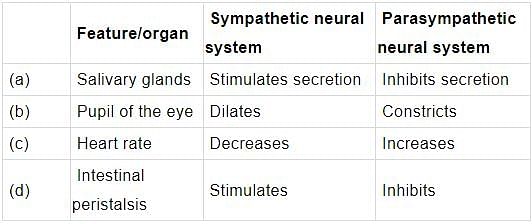NEET Exam > NEET Tests > Test: Human Neural System (NCERT) - NEET MCQ
Test: Human Neural System (NCERT) - NEET MCQ
Test Description
10 Questions MCQ Test - Test: Human Neural System (NCERT)
Test: Human Neural System (NCERT) for NEET 2024 is part of NEET preparation. The Test: Human Neural System (NCERT) questions and answers have been prepared
according to the NEET exam syllabus.The Test: Human Neural System (NCERT) MCQs are made for NEET 2024 Exam.
Find important definitions, questions, notes, meanings, examples, exercises, MCQs and online tests for Test: Human Neural System (NCERT) below.
Solutions of Test: Human Neural System (NCERT) questions in English are available as part of our course for NEET & Test: Human Neural System (NCERT) solutions in
Hindi for NEET course.
Download more important topics, notes, lectures and mock test series for NEET Exam by signing up for free. Attempt Test: Human Neural System (NCERT) | 10 questions in 10 minutes | Mock test for NEET preparation | Free important questions MCQ to study for NEET Exam | Download free PDF with solutions
Test: Human Neural System (NCERT) - Question 1
What is the primary function of the visceral nervous system within the peripheral nervous system?
Detailed Solution for Test: Human Neural System (NCERT) - Question 1
Test: Human Neural System (NCERT) - Question 2
Which of the following correctly describes the role of the central nervous system (CNS)?
Detailed Solution for Test: Human Neural System (NCERT) - Question 2
| 1 Crore+ students have signed up on EduRev. Have you? Download the App |
Detailed Solution for Test: Human Neural System (NCERT) - Question 3
Test: Human Neural System (NCERT) - Question 4
Which neural system is responsible for transmitting impulses to skeletal muscles?
Detailed Solution for Test: Human Neural System (NCERT) - Question 4
Detailed Solution for Test: Human Neural System (NCERT) - Question 5
Test: Human Neural System (NCERT) - Question 6
Which of the following options correctly identifies the effect of sympathetic and parasympathetic neural system on given features or organs?

Detailed Solution for Test: Human Neural System (NCERT) - Question 6
Detailed Solution for Test: Human Neural System (NCERT) - Question 7
Detailed Solution for Test: Human Neural System (NCERT) - Question 8
Test: Human Neural System (NCERT) - Question 9
During stress condition which of the following nerves start working?
Detailed Solution for Test: Human Neural System (NCERT) - Question 9
Detailed Solution for Test: Human Neural System (NCERT) - Question 10
Information about Test: Human Neural System (NCERT) Page
In this test you can find the Exam questions for Test: Human Neural System (NCERT) solved & explained in the simplest way possible.
Besides giving Questions and answers for Test: Human Neural System (NCERT), EduRev gives you an ample number of Online tests for practice
Download as PDF


















